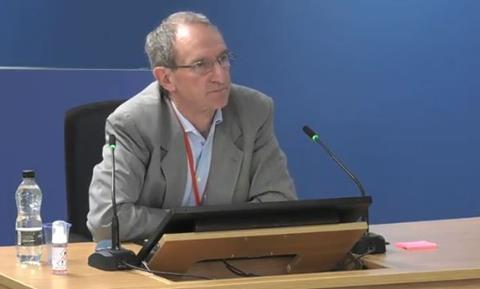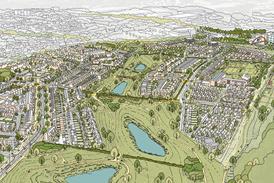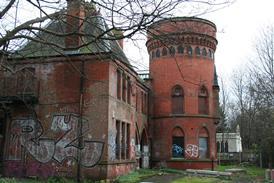Osborne Berry partner cannot explain how cavity barriers were placed back-to-front and wrong way around
One of the subcontractors responsible for fitting the external cladding system to Grenfell Tower has agreed that some of the fire protection measures that formed part of the package were fitted in a way that was “shocking” and “unacceptable”.
Mark Osborne, of Osborne Berry, made his observations to the Grenfell Tower Inquiry, probing the causes of 2017’s fire in which 72 lives were lost, on Monday.

He was shown images of cavity barriers – sometimes referred to as fire-breaks – installed on the tower in positions that were back-to-front and in the wrong orientation, failings that stopped them serving their intended purpose.
Osborne said he could not explain how the wrong installation, shown in one of inquiry expert witness Dr Barbara Lane’s post-disaster reports, had happened.
“It’s bugged me for a long time, the question about that,” he told the inquiry on Monday afternoon.
“I looked at these things in various locations many, many times and I never saw anything like that.”
Asked by inquiry barrister Kate Grange QC to explain why Osborne Berry never picked up the error, he replied: “I can’t, I’m afraid.”
Grange asked what Osborne would have done if he had seen the example in question. “It would have been pulled out and redone,” he said.
Osborne said he had never seen an example of cavity barriers being used the wrong way around on the site. “We never had this problem at all,” he added.
Grange said Lane had not found any correctly installed vertical fire barriers on the site and the vertical barriers all appeared to be manufacturer Siderise’s RH25 product, which was intended for horizontal installation.
Osborne said he was “shocked” that the correct vertical barriers weren’t installed.
He added: “As far as I’m aware, they were on the tower, because I fitted some of them myself.”
Osborne – known as ‘Taff’ to the Grenfell project team – was shown other images from Lane’s report that showed poorly fitted cavity barriers elsewhere that left gaps where smoke or flames could pass through.
Grange asked whether Osborne agreed the photographs were shocking. He replied: “I do.” Asked whether he thought it was “unacceptable”, Osborne said: “It certainly was.”
He was also asked if it was right to say the work had not been carried out with reasonable skill and care. Osborne said: “That’s correct.”
Manufacturer’s instructions
Osborne was asked whether he had read cavity barrier manufacturer Siderise’s installation instructions for the barriers before they were used as part of the Grenfell refurbishment.
Osborne said he had not but said he had installed cavity barriers on other jobs and had previously been given instructions on them. Presented with the Siderise documents, he said: “What I’m seeing here is no different to what was done on the tower.”
He also told the inquiry that he did not look at the manufacturers’ recommendations for installing the Celotex and Kingspan insulation put on Grenfell Tower, or the Reynobond PE 55 aluminium composite material (ACM) cladding used. Asked whether he was aware that the fixing used for the ACM was not the same as the manufacturer’s recommended method, Osborne said “no”.
He insisted that Osborne Berry’s workforce – which numbered up to 14 at the peak of the business’ involvement with the Grenfell refurbishment – had “most definitely” been given guidance on how to fit cavity barriers properly.
Osborne said the firm mostly used self-employed fitters and that he showed them what to do by working side-by-side with them on site – although he said it was not possible to do this with everyone when the project had eight different mast climbers, two for each face of the building.
“Some fitters would get checked more than others but some fitters wouldn’t get checked for a week on because we knew them and trusted them, basically,” he said. “The ones I checked most of all were the fitters we had from agencies. I wasn’t sure of them, basically.”
Osborne said the biggest difficulty with checking the correct installation of cavity barriers was that insulation was placed over them soon after they had been fitted to prevent them from being blown away by gusts of wind.
“You couldn’t see everything on the building before it was covered, basically,” he said. “It would even be hard for building control or the clerk of works to see some of these things.”
At the beginning of his evidence, Osborne told the inquiry that he had no formal training in rainscreen cladding and no formal training in fire safety. He said he had worked his way up through the industry after doing an apprenticeship as a fitter in the 1970s.
Complaints
Osborne was also asked about complaints received about “unacceptable behaviour” on the part of a member of the cladding installation team.
They were summarised in an April 2015 email from Rydon project manager Simon O’Connor who said there had been a number of complaints about one person knocking on residents’ windows asking for tea, scaring animals inside flats, showing a “complete lack of respect for health and safety” and criticising the quality of Rydon’s work.
Monday’s hearing was told that the allegations related to Osborne’s business partner Grahame Berry – known on the site as ‘Bez’.
Asked about the complaints, Osborne said he had known Berry for 35 years and did not believe he would behave in the way O’Connor described.
One of the health and safety issues involved fixers working for Osborne Berry climbing between mast climbers on the site.
Osborne said he had spoken to two workers about such behaviour but doubted Berry would ever have climbed between mast climbers.
“He doesn’t like heights to do that sort of thing,” Osborne said of his business partner.
The inquiry continues.
















No comments yet